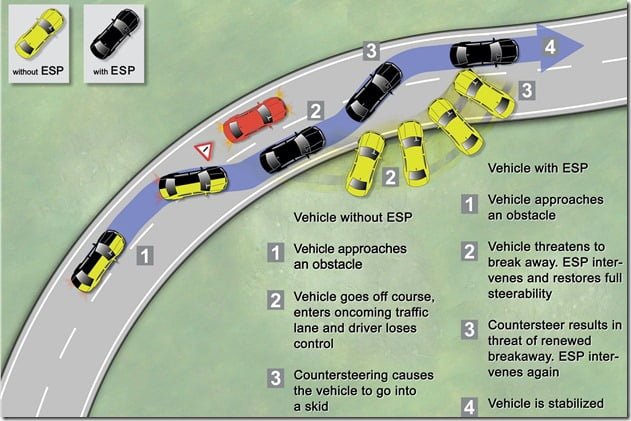Modern cars come equipped with a number of safety features which we aren’t even aware of. If we talk about some luxury cars and look at the safety features list we see two common features/systems, beside ABS, EBD and Airbags, which are Electronic Stability Program(ESP) and Traction Control System(TCS). People who have a good knowledge about cars know much about these features, however many first time buyers and even second time buyers, don’t even know the meaning of ESP and TCS. But according to me, one must have a clear picture about the features and their respective function.
Today we will be talking about ESP and TCS, two very important features that come as standard in most of the luxury cars.
What is Electronic Stability Program (ESP)? How ESP Works?
Electronic Stability Program is a system designed to help a vehicle maintain the trajectory as the driver wishes it to be. The system improves the stability of the vehicle in situations of abrupt emergency maneuver, turns taken too fast and even bad road surfaces where there is a great chance of losing tyre grip. When the tyres lose grip the driver loses control control over the vehicle but ESP detects this loss in steering control and automatically applies brakes to help the vehicle follow the path that the driver intends to.
Be its slippery roads or sudden swerves, the system helps keep the driver from losing control over the vehicle.

image credit – Path of A Car With Panic Braking With and Without ESP
The ESP as a system comprises of ABS, Traction Control System (we will be covering it later in the article) and a couple of sensors. The sensors monitor the vehicle’s behavior and provide real time data to the main unit. The main computer verifies the steering turning angle with the trajectory, if it does not comply with that the driver has desired, the system kicks in and regulates the speed of rotation of the wheels by using selective braking and therefore avoids loss of control. If the selective braking of wheels is insufficient to force the vehicle to follow the correct trajectory, the computer can even control the amount of engine torque and ignition system.
What is Traction Control System (TCS)? How TCS Works?
Traction Control system is considered to be a part of the ESP. It prevents loss of traction or adherence between the tires and the road. When the road conditions aren’t good enough for proper traction and the wheels start slipping, the TCS senses the wheel slip and reduces engine power or applies brakes to stop it. Whether the road surface is uneven or slippery, if you have traction control in your vehicle, it will ensure proper grip to accelerate the vehicle on such unfavorable surfaces. In case of wheel spin, the torque delivered by engine is not used efficiently on the road and the vehicle deviates from its intended path. Under such conditions, the TCS reduces the torque and brakes as well to bring the wheels in a state where the adequate gripping is available and thus helps the vehicle move on the intended path.
So basically it prevents tyres from skidding but it is not as effective as the ESP. While the ESP can do the same job as traction control, traction control cannot do the same job as ESP.
Video Demonstration of ABS, ESP and TCS
I hope this tech article will help you understand these technologies even better and wish you a safe future ahead. Drive Safe. Do check out some more popular Automobile Technology Articles here.
Also check out some interesting technology articles:
- What is ABS and how ABS and EBD Work?
- How MPFI Works?
- How CRDI Works?

